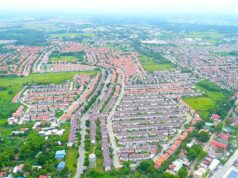HAGONOY, Bulacan – Travel time from this fishing town to Malolos City only takes 35 to 45 minutes, but Aura Pia Umali, a student of the Bulacan State University (BulSU) used to leave their house in Barangay San Nicolas hours before her classes actually start.
This is due to the rising sea water that inundates at least 18 of 26 villages of this town and other four other towns in the province that lies along the coast of Manila Bay.
For Umali and thousands other residents of coastal towns in the province, leaving their houses early either for work or attending classes is their way of adapting to changing climate that altered their daily lives.
But others have their own way of coping with the almost daily inundation that started almost 20 years ago.
Victoria Arguelles-Fernandez of Barangay San Sebastian had their bungalow-type house repaired and raised the pavement of the first floor of their house a meter compared its previous height.
They also constructed a second storey in preparation for deeper floods caused by typhoons like in 2009 when Ondoy dumped heavy rains and flooded more than half of the 569 villages in the province.
Of course, Arguelles-Fernandez house repair was completed with the assistance of her two younger brothers working abroad.
Others were not as lucky like the family of Lolita Garcia of Barangay San Jose. But they also learned to adapt by moving appliances on the first floor to the second floor of their house.
“We have to live with the high tide everyday because we don’t have enough money for house repair,” she said while showing the almost empty living room.
While many decided to face the daily inundation and make adjustments, others apparently heeded advice of experts to relocate.
One example is educator Fe Faundo who moved to Barangay Iba near the town of Calumpit.
“We thought it’s better to move to Iba because it is one of the villages that is not yet affected by high tide,” Faundo said.
But Faundo’s decision to relocate is partly influenced by the demands of her job. She is teaching at the nearby Iba Elementary School.
Indeed, not only daily lives of local residents are affected by the daily inundation, but their source of livelihood as well.
For Virgilio Santos and fellow tricycle drivers, the daily inundation is challenge as they cannot easily ply their usual routes.
As such, Santos discovered a way to continue earning a living while the roads are underwater.
Ingenuity led him to transform his tricycle into a “submarine tricycle” which can traverse flooded roads even if water is knee high and its exhaust is submerged.
Santos attached a meter-long rubber hose at the end of his tricycle’s exhaust pipe and tied it up with a strip of rubber cut from discarded interior tire.
While his ingenuity allowed Santos ply his usual route, the side-car and other metal parts of his tricycle are not free from rust brought by saline water.
For this, he is forced to regularly wash his tricycle and apply grease to some of its joints.
“I have to make this gamble to support my family,” he said noting that his ingenuity is paying off but also admitted that it greatly reduces the lifespan of the metal parts of his vehicle.
Like other residents of this coastal town, Santos said he is also hoping that promises of incumbent Mayor Angel Cruz will come true.
In the 2007 elections, Mayor Cruz campaigned with the promise that he will provide solutions to the rising sea water that inundates this town.
First, the mayor initiated construction of dikes along the river banks near the town proper, but later decided to rehabilitate roads by raising it up to a meter high.
The same was practiced in the coastal villages of Obando, Malolos, Paombong. However, such attempt only provided temporary relief to the travelling public.
Like in this coastal town, slow government intervention was overtaken by the fast changing climate. This was echoed by Gov. Wilhelmino Alvarado who served as mayor of this town from 1986 to 1998.
He said that the first infrastructure project he implemented in this town was the rehabilitation of the road running from Barangay San Pascual to Sto. Rosario in the late 80s.
“We raised the road by a meter, but before we completed the rehabilitation towards the town proper, the far end of the rehabilitated road in San Pascual was already underwater,” he said
At present, Alvarado proposes the construction of the coastal highway that will link the provinces of Cavite and Bataan, but will pass along the coast of Bulacan and Pampanga.
He said that the proposed coastal road will serve many purpose, like breaker to waves that damages fishponds on the coast of Bulacan, flood control that will prevent sea water from inundating coastal towns, and as a road itself which will cut travel time between Cavite and Bataan by more than hour.




